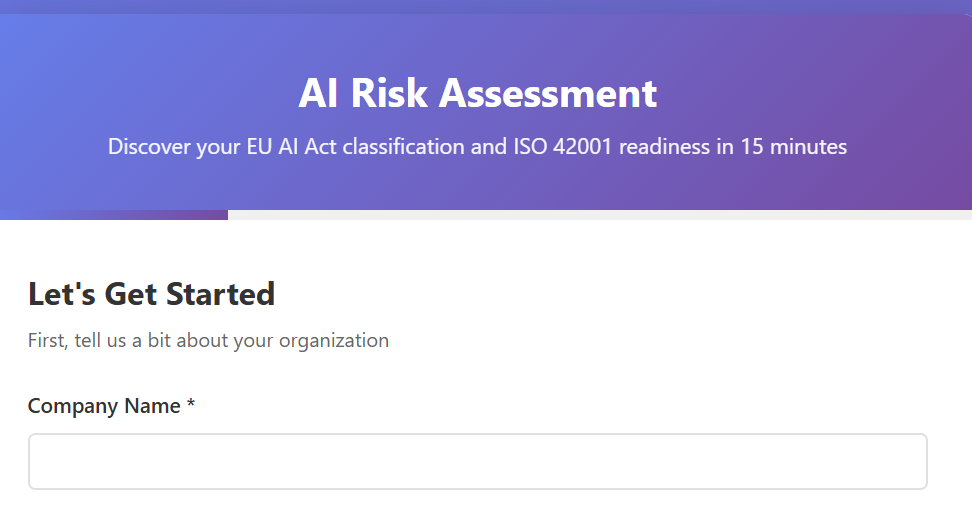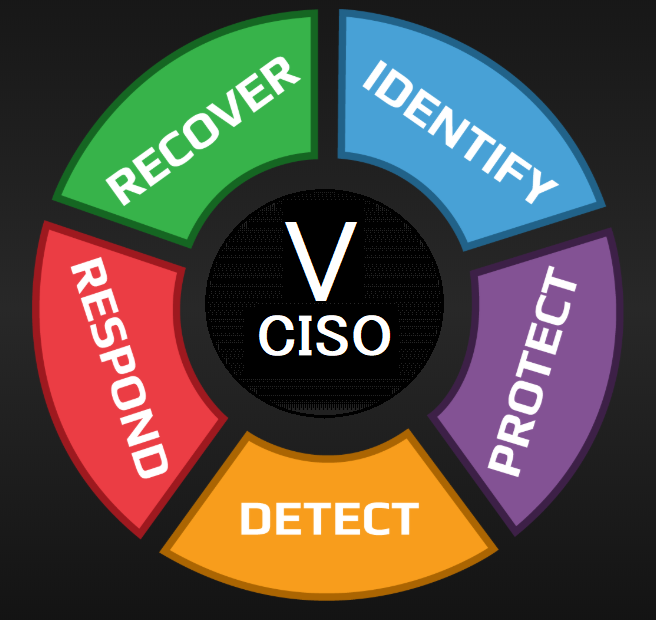Building an Effective AI Risk Assessment Process: A Practical Guide

As organizations rapidly adopt artificial intelligence, the need for structured AI risk assessment has never been more critical. With regulations like the EU AI Act and standards like ISO 42001 reshaping the compliance landscape, companies must develop systematic approaches to evaluate and manage AI-related risks.
Why AI Risk Assessment Matters
Traditional IT risk frameworks weren’t designed for AI systems. Unlike conventional software, AI systems learn from data, evolve over time, and can produce unpredictable outcomes. This creates unique challenges:
- Regulatory Complexity: The EU AI Act classifies systems by risk level, with severe penalties for non-compliance
- Operational Uncertainty: AI decisions can be opaque, making risk identification difficult
- Rapid Evolution: AI capabilities and risks change as models are retrained
- Multi-stakeholder Impact: AI affects customers, employees, and society differently
Check your AI 👇 readiness in 5 minutes—before something breaks.
Free instant score + remediation plan.

The Four-Stage Assessment Framework
An effective AI risk assessment follows a structured progression from basic information gathering to actionable insights.
Stage 1: Organizational Context
Understanding your organization’s AI footprint begins with foundational questions:
Company Profile
- Size and revenue (risk tolerance varies significantly)
- Industry sector (different regulatory scrutiny levels)
- Geographic presence (jurisdiction-specific requirements)
Stakeholder Identification
- Who owns AI procurement decisions?
- Who bears accountability for AI outcomes?
- Where does AI governance live organizationally?
This baseline helps calibrate the assessment to your organization’s specific context and risk appetite.
Stage 2: AI System Inventory
The second stage maps your actual AI implementations. Many organizations underestimate their AI exposure by focusing only on custom-built systems while overlooking:
- Customer-Facing Systems: Chatbots, recommendation engines, virtual assistants
- Operational Systems: Fraud detection, predictive analytics, content moderation
- HR Systems: Resume screening, performance prediction, workforce optimization
- Financial Systems: Credit scoring, loan decisioning, insurance pricing
- Security Systems: Biometric identification, behavioral analysis, threat detection
Each system type carries different risk profiles. For example, biometric identification and emotion recognition trigger higher scrutiny under the EU AI Act, while predictive analytics may have lower inherent risk but broader organizational impact.
Stage 3: Regulatory Risk Classification
This critical stage determines your compliance obligations, particularly under the EU AI Act which uses a risk-based approach:
High-Risk Categories Systems that fall into these areas require extensive documentation, testing, and oversight:
- Employment decisions (hiring, firing, promotion, task allocation)
- Credit and lending decisions
- Insurance pricing and claims processing
- Educational access or grading
- Law enforcement applications
- Critical infrastructure management (energy, transportation, water)
Risk Multipliers Certain factors elevate risk regardless of system type:
- Direct interaction with EU consumers or residents
- Use of biometric data or emotion recognition
- Impact on vulnerable populations
- Deployment in regulated sectors (healthcare, finance, education)
Risk Scoring Methodology A quantitative approach helps prioritize remediation:
- Assign base scores to high-risk categories (3-4 points each)
- Add points for EU consumer exposure (+2 points)
- Add points for sensitive technologies like biometrics (+3 points)
- Calculate total risk score to determine classification
Example thresholds:
- HIGH RISK: Score ≥5 (immediate compliance required)
- MEDIUM RISK: Score 2-4 (enhanced governance needed)
- LOW RISK: Score <2 (standard controls sufficient)
Stage 4: ISO 42001 Control Gap Analysis
The final stage evaluates your AI management system maturity against international standards. ISO 42001 provides a comprehensive framework covering:
A.4 – AI Policy Framework
- Are AI policies documented, approved, and maintained?
- Do policies cover ethical use, data handling, and accountability?
- Are policies communicated to relevant stakeholders?
Gap Impact: Without policy foundation, you lack governance structure and face regulatory penalties.
A.6 – Data Governance
- Do you track AI training data sources systematically?
- Is data quality, bias, and lineage documented?
- Can you prove data provenance during audits?
Gap Impact: Poor data tracking creates audit failures and enables undetected bias propagation.
A.8 – AI Incident Management
- Are AI incident response procedures documented and tested?
- Do procedures cover detection, containment, and recovery?
- Are escalation paths and communication protocols defined?
Gap Impact: Without incident procedures, AI failures cause business disruption and regulatory violations.
A.5 – AI Impact Assessment
- Do you conduct regular impact assessments?
- Are assessments comprehensive (fairness, safety, privacy, security)?
- Is assessment frequency appropriate to system criticality?
Gap Impact: Infrequent assessments allow risks to accumulate undetected over time.
A.9 – Transparency & Explainability
- Can you explain AI decision-making to stakeholders?
- Is documentation appropriate for technical and non-technical audiences?
- Are explanation mechanisms built into systems, not retrofitted?
Gap Impact: Inability to explain decisions violates transparency requirements and damages stakeholder trust.
Implementing the Assessment Process
Technical Implementation Considerations
When building an assessment tool – key design principles include:
Progressive Disclosure
- Break assessment into digestible sections with clear progress indicators
- Use branching logic to show only relevant questions
- Validate each section before allowing progression
User Experience
- Visual feedback for risk levels (color-coded: red/high, yellow/medium, green/low)
- Clear section descriptions explaining “why” questions matter
- Mobile-responsive design for completion flexibility
Data Collection Strategy
- Mix question types: multiple choice for consistency, checkboxes for comprehensive coverage
- Require critical fields while making others optional
- Save progress to prevent data loss
Scoring Algorithm Transparency
- Document risk scoring methodology clearly
- Explain how answers translate to risk levels
- Provide immediate feedback on assessment completion
Automated Report Generation
Effective assessments produce actionable outputs:
Risk Level Summary
- Clear classification (HIGH/MEDIUM/LOW)
- Plain language explanation of implications
- Regulatory context (EU AI Act, ISO 42001)
Gap Analysis
- Specific control deficiencies identified
- Business impact of each gap explained
- Prioritized remediation recommendations
Next Steps
- Concrete action items with timelines
- Resources needed for implementation
- Quick wins vs. long-term initiatives
From Assessment to Action
The assessment is just the beginning. Converting insights into compliance requires:
Immediate Actions (0-30 days)
- Address critical HIGH RISK findings
- Document current AI inventory
- Establish incident response contacts
Short-term Actions (1-3 months)
- Develop missing policy documentation
- Implement data governance framework
- Create impact assessment templates
Medium-term Actions (3-6 months)
- Deploy monitoring and logging
- Conduct comprehensive impact assessments
- Train staff on AI governance
Long-term Actions (6-12 months)
- Pursue ISO 42001 certification
- Build continuous compliance monitoring
- Mature AI governance program
Measuring Success
Track these metrics to gauge program maturity:
- Coverage: Percentage of AI systems assessed
- Remediation Velocity: Average time to close gaps
- Incident Rate: AI-related incidents per quarter
- Audit Readiness: Time needed to produce compliance documentation
- Stakeholder Confidence: Survey results from users, customers, regulators
Conclusion
AI risk assessment isn’t a one-time checkbox exercise. It’s an ongoing process that must evolve with your AI capabilities, regulatory landscape, and organizational maturity. By implementing a structured four-stage approach—organizational context, system inventory, regulatory classification, and control gap analysis—you create a foundation for responsible AI deployment.
The assessment tool we’ve built demonstrates that compliance doesn’t have to be overwhelming. With clear frameworks, automated scoring, and actionable insights, organizations of any size can begin their AI governance journey today.
Ready to assess your AI risk? Start with our free assessment tool or schedule a consultation to discuss your specific compliance needs.
About DeuraInfoSec: We specialize in AI governance, ISO 42001 implementation, and information security compliance for B2B SaaS and financial services companies. Our practical, outcome-focused approach helps organizations navigate complex regulatory requirements while maintaining business agility.
Free AI Risk Assessment: Discover Your EU AI Act Classification & ISO 42001 Gaps in 15 Minutes
A progressive 4-stage web form that collects company info, AI system inventory, EU AI Act risk factors, and ISO 42001 readiness, then calculates a risk score (HIGH/MEDIUM/LOW), identifies control gaps across 5 key ISO 42001 areas. Built with vanilla JavaScript, uses visual progress tracking, color-coded results display, and includes a CTA for Calendly booking, with all scoring logic and gap analysis happening client-side before submission. Concise, tailored high-level risk snapshot of your AI system.
What’s Included:
✅ 4-section progressive flow (15 min completion time) ✅ Smart risk calculation based on EU AI Act criteria ✅ Automatic gap identification for ISO 42001 controls ✅ PDF generation with 3-page professional report ✅ Dual email delivery (to you AND the prospect) ✅ Mobile responsive design ✅ Progress tracking visual feedback
Click below 👇 to launch your AI Risk Assessment.

CISO MindMap 2025 by Rafeeq Rehman

- A Simple 4-Step Path to ISO 42001 for SMBs
- How ISO 42001 Strengthens Alignment With the EU AI Act (Without Replacing Legal Compliance)
- When a $3K “cybersecurity gap assessment” reveals you don’t actually have cybersecurity to assess…
- ISO 42001 and the Business Imperative for AI Governance
- Emerging Tools & Frameworks for AI Governance & Security Testing
InfoSec services | InfoSec books | Follow our blog | DISC llc is listed on The vCISO Directory | ISO 27k Chat bot | Comprehensive vCISO Services | ISMS Services | Security Risk Assessment Services | Mergers and Acquisition Security




